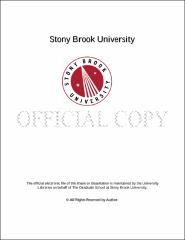| dc.identifier.uri | http://hdl.handle.net/11401/76706 | |
| dc.description.sponsorship | This work is sponsored by the Stony Brook University Graduate School in compliance with the requirements for completion of degree. | en_US |
| dc.format | Monograph | |
| dc.format.medium | Electronic Resource | en_US |
| dc.language.iso | en_US | |
| dc.publisher | The Graduate School, Stony Brook University: Stony Brook, NY. | |
| dc.type | Dissertation | |
| dcterms.abstract | The scattering of subatomic particles is a source of important physical phenomena. Decades of work have yielded many techniques for the computation of scattering amplitudes. Most of these techniques involve perturbative quantum field theory and thus apply only at weak coupling. Complementary to scattering is the formation of bound states, which are intrinsically nonperturbative. Regge theory arose in the late 1950s as an attempt to describe, with a single framework, both scattering and the formation of bound states. In Regge theory one obtains an amplitude with bound state poles after analytic continuation of a nonperturbative scattering amplitude, corresponding to a sum of an infinite number of Feynman diagrams at large energy and fixed momentum transfer (but with crossed kinematics). Thus, in order to obtain bound states at fixed energy, one computes an amplitude at large momentum transfer. In this dissertation we calculate amplitudes with bound states in the regime of fixed energy and small momentum transfer. We formulate the elastic scattering problem in terms of many-body path integrals, familiar from quantum mechanics. Then we invoke the semiclassical JWKB approximation, where the path integral is dominated by classical paths. The dynamics in the semiclassical regime are strongly coupled, as found by Halpern and Siegel. When the momentum transfer is small, the classical paths are simple straight lines and the resulting semiclassical amplitudes display a spectrum of bound states that agrees with the spectrum found by solving wave equations with potentials. In this work we study the bound states of matter particles with various types of interactions, including electromagnetic and gravitational interactions. Our work has many analogies with the work started by Alday and Maldacena, who computed scattering amplitudes of gluons at strong coupling with semiclassical quantum mechanics of strings in anti de-Sitter spacetime. We hope that in the future we can apply our methods to nonabelian matter and better understand bound states in quantum chromodynamics. | |
| dcterms.available | 2017-09-20T16:51:01Z | |
| dcterms.contributor | van Nieuwenhuizen, Peter | en_US |
| dcterms.contributor | Siegel, Warren D | en_US |
| dcterms.contributor | Deshpande, Abhay | en_US |
| dcterms.contributor | Grushevsky, Samuel. | en_US |
| dcterms.creator | Irizarry-Gelpi, Melvin Eloy | |
| dcterms.dateAccepted | 2017-09-20T16:51:01Z | |
| dcterms.dateSubmitted | 2017-09-20T16:51:01Z | |
| dcterms.description | Department of Physics. | en_US |
| dcterms.extent | 171 pg. | en_US |
| dcterms.format | Application/PDF | en_US |
| dcterms.format | Monograph | |
| dcterms.identifier | http://hdl.handle.net/11401/76706 | |
| dcterms.issued | 2013-12-01 | |
| dcterms.language | en_US | |
| dcterms.provenance | Made available in DSpace on 2017-09-20T16:51:01Z (GMT). No. of bitstreams: 1
IrizarryGelpi_grad.sunysb_0771E_11524.pdf: 1138644 bytes, checksum: 0133d1084ed8e32dd89d04bf5acefd50 (MD5)
Previous issue date: 1 | en |
| dcterms.publisher | The Graduate School, Stony Brook University: Stony Brook, NY. | |
| dcterms.subject | Theoretical physics | |
| dcterms.subject | Bound States, Scattering, Semiclassical | |
| dcterms.title | Eikonal Scattering at Strong Coupling | |
| dcterms.type | Dissertation | |

